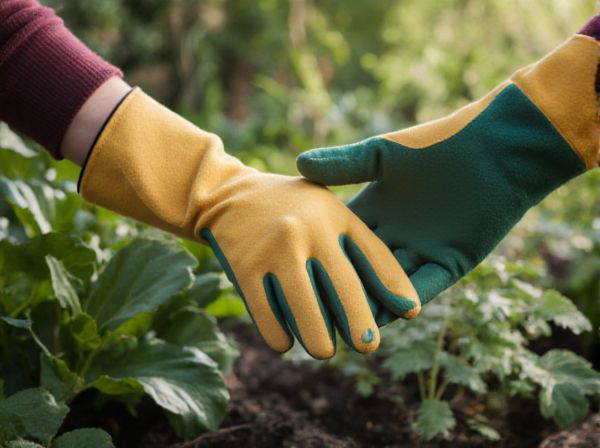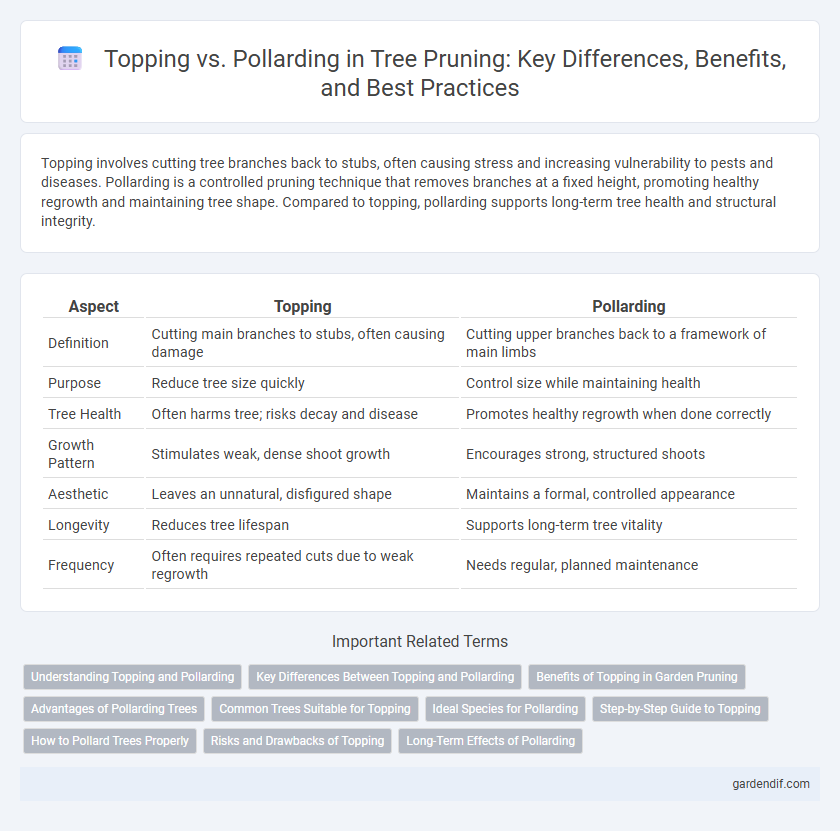
Topping vs Pollarding Illustration
Topping involves cutting tree branches back to stubs, often causing stress and increasing vulnerability to pests and diseases. Pollarding is a controlled pruning technique that removes branches at a fixed height, promoting healthy regrowth and maintaining tree shape. Compared to topping, pollarding supports long-term tree health and structural integrity.
Table of Comparison
| Aspect | Topping | Pollarding |
|---|---|---|
| Definition | Cutting main branches to stubs, often causing damage | Cutting upper branches back to a framework of main limbs |
| Purpose | Reduce tree size quickly | Control size while maintaining health |
| Tree Health | Often harms tree; risks decay and disease | Promotes healthy regrowth when done correctly |
| Growth Pattern | Stimulates weak, dense shoot growth | Encourages strong, structured shoots |
| Aesthetic | Leaves an unnatural, disfigured shape | Maintains a formal, controlled appearance |
| Longevity | Reduces tree lifespan | Supports long-term tree vitality |
| Frequency | Often requires repeated cuts due to weak regrowth | Needs regular, planned maintenance |
Understanding Topping and Pollarding
Topping involves cutting tree branches back to stubs, often leading to stress, decay, and an unnatural appearance, while pollarding is a controlled pruning technique that removes upper branches to promote a dense head of foliage. Unlike topping, pollarding encourages new growth by cutting branches at specific points, maintaining tree health and shape. Understanding the differences between these methods is essential for selecting a pruning technique that supports long-term tree vitality and aesthetics.
Key Differences Between Topping and Pollarding
Topping involves cutting the main branches of a tree back to stubs, often causing stress, decay, and an unnatural growth pattern, whereas pollarding is a controlled pruning technique that removes branches at a fixed point to promote dense, healthy regrowth. The key differences lie in their impact on tree health: topping typically weakens trees by stripping large amounts of foliage, while pollarding maintains tree structure and vitality by encouraging regular, sustainable growth cycles. Pollarding is usually performed on specific tree species adapted to this method, whereas topping is generally discouraged due to its harmful long-term effects.
Benefits of Topping in Garden Pruning
Topping in garden pruning significantly reduces tree height, promoting better light penetration and air circulation for surrounding plants. This method encourages vigorous new growth, enhancing the overall aesthetics and density of the garden canopy. Topping also facilitates easier maintenance and management of tree size, making it ideal for controlling overgrown trees in residential landscapes.
Advantages of Pollarding Trees
Pollarding trees promotes healthy regrowth by maintaining a balanced canopy, reducing the risk of branch failure compared to topping. This technique encourages vigorous new shoots while preserving structural integrity, enhancing tree longevity and aesthetic appeal. Pollarding also controls tree size effectively, making it ideal for urban environments where space and safety are priorities.
Common Trees Suitable for Topping
Common trees suitable for topping include species like oak, maple, and poplar, which can tolerate significant crown reduction due to their vigorous growth patterns. Topping involves cutting back large branches to stubs or lateral branches that are not large enough to assume the terminal role, often leading to rapid sprouting and dense regrowth in these tree types. Although topping can reduce tree height and manage size, it is generally discouraged for health reasons, as it can cause stress and vulnerability to pests and diseases in these commonly topped species.
Ideal Species for Pollarding
Ideal species for pollarding include plane trees (Platanus spp.), willows (Salix spp.), and linden (Tilia spp.), all renowned for their vigorous regrowth capacity and tolerance to repeated cutting. Pollarding suits these species because their ability to produce dense, controllable crowns helps maintain urban landscapes and prolongs tree lifespan. Unlike topping, which can harm structural integrity, pollarding supports sustainable pruning by preserving tree health in species adapted to this technique.
Step-by-Step Guide to Topping
Topping involves cutting back the main branches of a tree to stubs or lateral branches to reduce size, often causing stress and vulnerability. To properly top a tree, first identify the main branches to be trimmed, then make clean cuts just outside the branch collar to promote healing, and ensure cuts are evenly spaced to maintain tree structure. Use sharp, sterilized tools, remove no more than 25-30% of the canopy, and monitor the tree regularly to manage regrowth and prevent damage.
How to Pollard Trees Properly
Pollarding involves cutting back the main branches of a tree to a predetermined point, typically above a strong bud or branch union, to encourage dense new growth while maintaining tree health and structure. Proper pollarding requires consistent timing, usually in late winter or early spring before bud break, to minimize stress and promote vigorous regeneration. Maintaining a clear, clean cut with sharp tools helps prevent disease and ensures the tree's natural form is preserved through repeated cycles.
Risks and Drawbacks of Topping
Topping severely damages tree health by removing large branches, leading to weak regrowth vulnerable to pests and diseases. This practice increases the risk of decay and structural failure, posing safety hazards and costly maintenance. Unlike pollarding, topping disrupts the natural growth pattern, often resulting in unsightly, stressful wounds that compromise long-term tree vitality.
Long-Term Effects of Pollarding
Pollarding promotes sustainable tree growth by encouraging dense, new shoots that maintain structural balance over time, reducing the risk of weak limb formation common in topping. This method extends the lifespan of trees and preserves their health by minimizing stress and preventing decay in major branches. Long-term benefits include enhanced resilience to environmental factors and maintained aesthetic form, making pollarding a preferred technique for urban tree management.
Topping vs Pollarding Infographic

 gardendif.com
gardendif.com